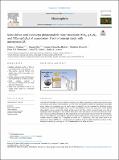Solar-driven semi-conductor photocatalytic water treatment (TiO2, g-C3N4, and TiO2+g-C3N4) of cyanotoxins : proof-of-concept study with microcystin-LR
Abstract
Cyanobacteria and their toxins are a threat to drinking water safety as increasingly cyanobacterial blooms (mass occurrences) occur in lakes and reservoirs all over the world. Photocatalytic removal of cyanotoxins by solar light active catalysts is a promising way to purify water at relatively low cost compared to modifying existing infrastructure. We have established a facile and low-cost method to obtain TiO2 and g-C3N4 coated floating photocatalysts using recycled glass beads. g-C3N4 coated and TiO2+g-C3N4 co-coated beads were able to completely remove microcystin-LR in artificial fresh water under both natural and simulated solar light irradiation without agitation in less than 2 h. TiO2 coated beads achieved complete removal within 8 h of irradiation. TiO2+g-C3N4 beads were more effective than g-C3N4 beads as demonstrated by the increase reaction rate with reaction constants, 0.0485 min−1 compared to 0.0264 min−1 respectively, with TiO2 alone found to be considerably slower 0.0072 min−1. g-C3N4 based photocatalysts showed a similar degradation pathway to TiO2 based photocatalysts by attacking the C6–C7 double bond on the Adda side chain.
Citation
Pestana , C J , Hui , J , Camacho-Muñoz , D , Edwards , C , Robertson , P K J , Irvine , J T S & Lawton , L A 2023 , ' Solar-driven semi-conductor photocatalytic water treatment (TiO 2 , g-C 3 N 4 , and TiO 2 +g-C 3 N 4 ) of cyanotoxins : proof-of-concept study with microcystin-LR ' , Chemosphere , vol. 310 , 136828 . https://doi.org/10.1016/j.chemosphere.2022.136828
Publication
Chemosphere
Status
Peer reviewed
ISSN
1879-1298Type
Journal article
Description
Funding: We acknowledge the funding provided by the Engineering and Physical Sciences Research Council, UK (Global Challenge Research Fund: EP/P029280/1) towards carrying out this research. We also thank the support on electron microscopes from EPSRC Capital for Great Technologies (Grant EP/LP017008/1 and EP/R02375/1).Collections
Items in the St Andrews Research Repository are protected by copyright, with all rights reserved, unless otherwise indicated.

